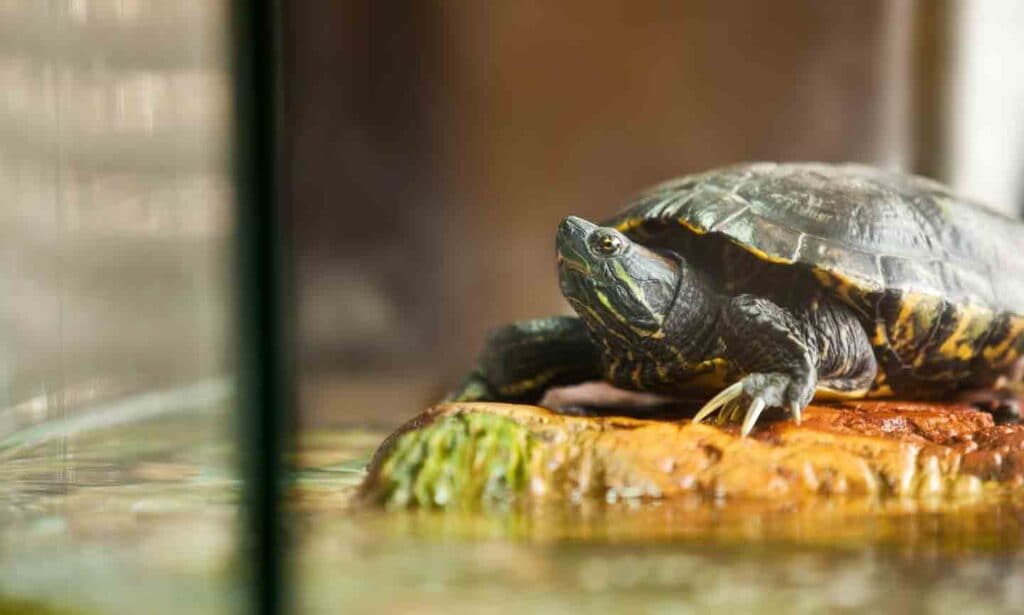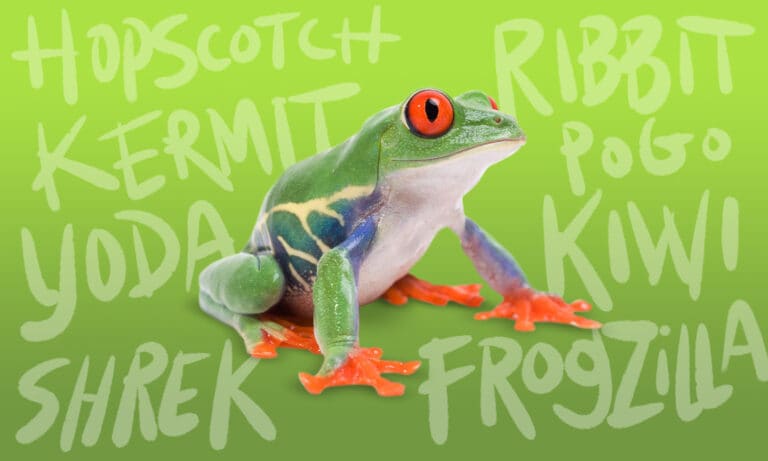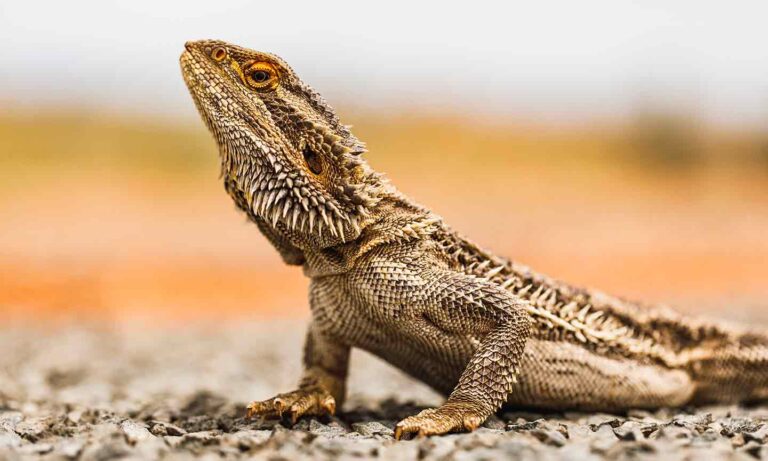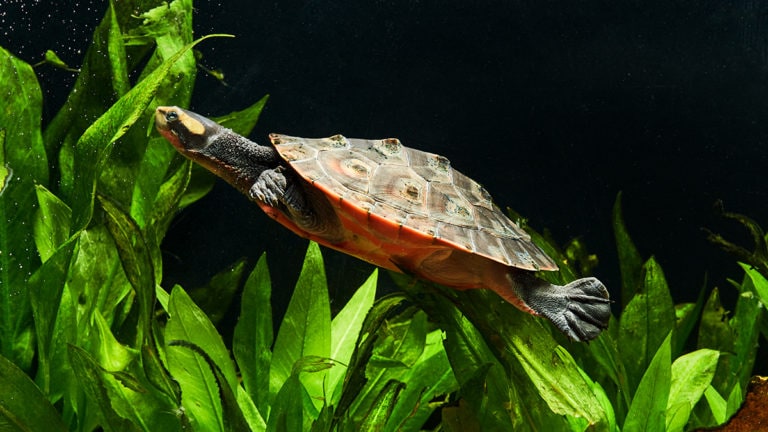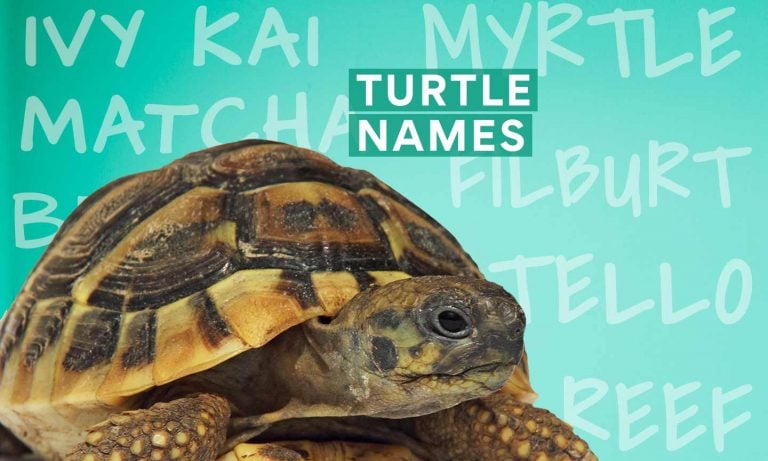In This Guide:
New Turtle Tank Checklist
Here’s everything you’ll need to set up your new turtle tank:
- Tank or terrarium
- Tank cover
- Bedding and substrate
- Ultraviolet lights
- Heat lamps
- Aquarium heater
- Thermometer
- Water filter
- Basking platforms
- Turtle food
Read on for expert advice on choosing the perfect products for your pet.
Turtle Tank
Glass aquariums are the most common type of enclosure for semi-aquatic turtles (e.g., red-eared slider turtles, yellow-bellied sliders, painted turtles, map turtles, pond turtles) and aquatic turtles (e.g., softshell turtles and matamatas). However, some pet parents may opt for stock watering tanks, large plastic bins, or even ponds.
When deciding on an enclosure for your turtle, what’s most important is that it’s large enough for your hard-shelled friend to thrive once they’re fully grown. How large they grow will vary depending on their species and gender. You can get a smaller fish tank for a baby turtle then upgrade to a bigger tank size as they grow, or you can choose a large, spacious tank to start with.
It’s recommended that your turtle has enough room to swim at least four to five body lengths before having to turn around, with a water level that’s 1.5-2 times as deep as their shell length.
In short … the bigger, the better!
Tank Cover
Though their slow speed can be deceiving, some turtles are Houdini-level escape artists—making tank covers a necessity. Tank covers can also be helpful to protect your turtle if you have any other pets, like curious cats and dogs.
The cover should be placed with at least a few inches of air space between the water and top of the tank to prevent your turtle from climbing out.
A tank cover should be durable, easy to install, and—most importantly—allow UV light to enter your turtle’s enclosure, like the Exo Terra® screen cover.
Substrate
Substrate or bedding is material that is used to cover the bottom of the tank. This is optional, as it’s mostly for aesthetics. Substrate does require some careful considerations, though—and is more to clean!
Appropriate substrate options will vary depending on your turtle’s species. If you decide to include a substrate in your turtle’s tank, make sure it’s safe for your turtle—in other words, that it’s too big for them to eat. Some turtles will eat just about anything in sight, and certain substrate materials can be dangerous for turtles if ingested, including:
- Corncobs
- Crushed walnut shells
- Gravel
- Sand
If you’d like to use substrate in your turtle’s tank, consider these safer options:
- Turtle-safe soil
- Coconut fiber
- Large river rocks
- Newspaper
- Artificial turf
- Paper towels
- Bark mulch
- Alfalfa pellets (for dry environments)
Make sure your substrate does not hide debris or waste in your turtle tank; that’ll make it easier to see when it’s time to clean.
Lighting
As cold-blooded animals, turtles require UV lighting and natural sunlight to stay healthy. A light with a full-spectrum UVA/UVB bulb has similar benefits to natural sunlight and includes ultraviolet rays, which improves feeding behavior, calcium absorption, shell growth, and activity.
Look for ultraviolet-producing fluorescent lights or mercury vapor bulbs that range 290-320 nanometer wavelengths. It’s recommended to leave lights on for 12 hours a day. Change your UV bulbs regularly, as they can stop emitting UV even though they still produce light.
You’ll also want a basking light that ranges 50-75 watts.
Heating
Adequate heating is crucial to a turtle’s overall health, from helping with digestion to maintaining a strong immune system. There are several types of heating that can be used in your turtle tank, such as:
- Incandescent light bulbs: 50-150 watts
- Infrared bulb: 250 watts
- Porcelain heating elements
Heating requirements vary based on species. However, generally speaking, semi-aquatic and aquatic turtles will require:
- A basking area ranging 85-95 degrees Fahrenheit
- An air temperature ranging 75-85 degrees Fahrenheit
To keep the water warm enough for your turtle, use a submersible aquarium heater to maintain temperatures of 72-82 degrees Fahrenheit, depending on your turtle species.
Thermometer
Thermometers help with constantly checking temperatures in your turtle’s tank. Both air and water temperatures need to be kept consistent, as abrupt changes and temperature extremes can be fatal. A high-quality thermometer will be reliable, submersible, and easy to read.
Water
The general rule for how much water a turtle needs in their tank—at minimum—is 10 gallons of water for every inch of carapace (the upper shell) length.
Safe water options include:
- Dechlorinated tap water
- Aged tap water
- Bottled water
- Reverse osmosis water
“Since turtles don’t breathe their water the way fish do, the water minerals are not quite as important,” says Price Dickson, DVM, a veterinarian at My Pet’s Animal Hospital in Lakeland, Florida. “Dechlorinated tap water is usually fine,” she says.
Filter
Filtration helps improve the water quality, keeping it clean and healthy for your pet turtle. Plus, filters are great for reducing how often you’ll need to do water changes—compared to without one—which means more time to spend bonding with your turtle!
When choosing a water filter, look for one that’s rated for at least a 75-gallon tank. “The more efficient the filter, the better!” Dr. Dickson says. Even if you have a 50-gallon tank, a 75-gallon filter will simply filter the tank water more times per day and keep the water cleaner, she adds.
“It’s never a mistake to over-buy in the filter department, especially if you end up getting a larger tank later,” she says. “Honestly, since turtles make so much more waste than fish, I recommend always getting a stronger filter than your tank ‘needs.’”
Dr. Dickson breaks down the three types of filter media:
- Mechanical: Uses physical materials like sand and beads to trap large particles, such as food, waste, or debris, and remove them from the water.
- Biological: Uses a special filter to grow bacteria, which eat nitrogen, removing chemical waste from the tank ecosystem.
- Chemical: Uses activated charcoal to bind and remove toxins.
She recommends using a filter that has all three types of filter media. That way, solid, organic, and inorganic wastes are removed.
Filter options include:
- External canister filters, like the Eheim Classic 250 Filter
- Internal power filters, like the Marineland Magnum® Polishing Filter
Basking Platform
After spending time in the water, turtles need a way to get out so that they can dry off and get warm, or bask, which allows them to regulate their body temperature.
To set up a basking site or turtle dock, you’ll need a platform with a ramp that makes it easy for them to climb out from the water to dry land. The basking platform should be safe, secure, and able to support your turtle’s weight.
How To Set Up Your New Turtle Tank
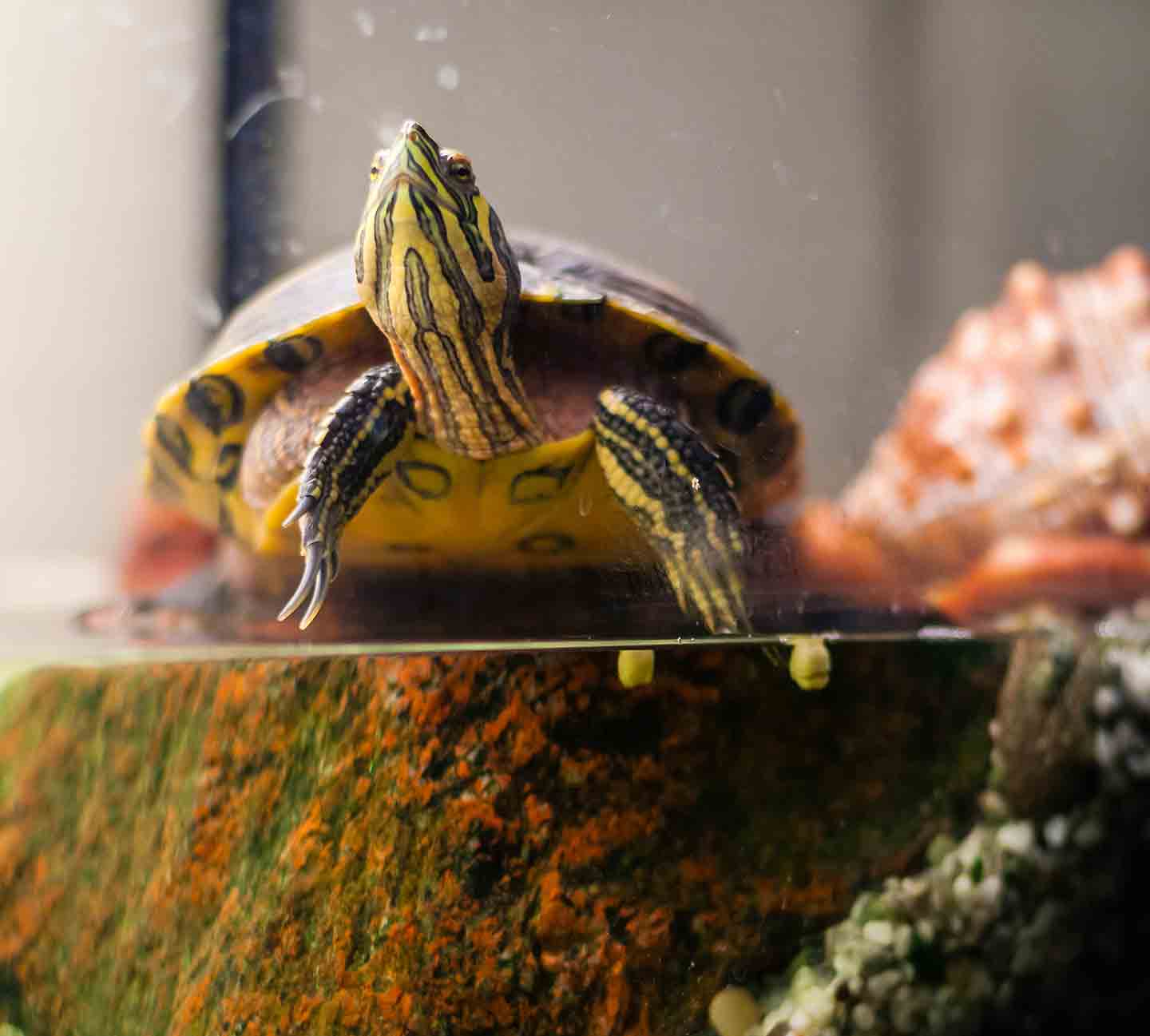
- Choose a good place for your tank. Your turtle’s habitat should sit on a surface that can support a heavy tank, like a sturdy table or cabinet. It should be placed away from windows and direct sunlight, which can harm your turtle.
- Create a dry land area with a ramp. Semi-aquatic and aquatic turtles need an area of dry land to bask and rest their adorably webbed feet. A ramp will make it easy for them to get out of the water and onto dry land, where they’ll bask for hours at a time.
- Add substrate. This step is optional, as substrate isn’t necessary, but it can provide your turtle with some enrichment and add visual appeal to your tank. Make sure any substrate placed in the tank is too large for your turtle to ingest.
- Add decor and other non-electric accessories. Place turtle-friendly decor and other essentials, like thermometers, in the tank. Place one thermometer in the basking area and another on the cool side of the tank or just outside the tank.
- Add water. Fill the tank with the appropriate amount of turtle-safe water based on your turtle’s size.
- Add electric accessories. Place UV lights within 18 inches from your turtle’s basking area. If needed, use a submersible aquarium water heater.
- Introduce your turtle. Show your turtle their new habitat, and watch them explore their setup at their pace!
How To Clean Your Turtle Tank
Cleaning and maintaining your turtle’s tank are essential for keeping them happy and healthy.
You’ll need a scrub brush or scrubbing pad that can be washed and sanitized after cleaning your turtle’s enclosure, as well as a dilute solution of bleach (1/4 cup of bleach to 1 gallon of water), says Doug Mader, MSc, DVM, of Big Pine, Florida, a triple board-certified veterinary specialist and author of “The Vet at Noah’s Ark.” Make sure to use a turtle-safe cleaner, because some general-use cleansers can be toxic to turtles.
Dr. Mader says everything in your turtle’s tank should be cleaned thoroughly:
- The water needs to be changed.
- The substrate should be rinsed thoroughly or replaced.
- The walls of the tank should be scrubbed and cleaned.
- Any cage furniture or decorations, like rocks, should be cleaned and rinsed.
Here’s a step-by-step on how to clean the tank:
- Using a scrub brush or scrubbing pad and hot water, scrub your turtle’s tank and all objects inside it.
- After scrubbing, soak all tank objects in a dilute solution of 1/4 cup of bleach per gallon of water for 10-15 minutes. Do not use common chemical cleaners such as Lysol, which can be dangerous to your pet.
- After soaking, use unscented antibacterial soap to clean the objects.
- Rinse the objects thoroughly in fresh water to ensure there is no bleach or soap residue left behind.
- Leave objects in the sun to dry. (This will help neutralize any bleach remnants.)
Here’s a general idea of what needs to be cleaned and how often:
- Daily: Spot-clean organic debris (such as uneaten food, feces, urine, dead plants) to prevent the risk of internal parasites; ideally within 12 hours of feeding
- Weekly: Scrub the tank
- Monthly: Do complete water/tank changes and cleanings; replace substrates
Note: Cleaning will be more frequent if you have more than one turtle in the tank.
When cleaning, make sure to disinfect any tools used to remove waste. Because turtles can carry salmonella, it’s important to wash your hands immediately after cleaning the tank or handling your turtle.
FAQs About A Turtle's Tank Setup
Q:Should you put sand in your turtle tank?
A:Dr. Mader advises against putting sand in your turtle tank, as it can clog filters and cause digestive tract impactions (gastrointestinal blockages) if ingested.
Q:What substrate is best for baby red-eared sliders?
A:Aquarium gravel and pebbles are good substrate options for baby red-eared sliders, according to Dr. Mader. Any gravel or pebbles should be too large for your turtle to ingest.
Q:Can fish live with your pet turtle?
A:Generally, no. Many turtles eat fish. If the fish are large enough, they may do fine, Dr. Mader says. However, even smaller turtles may harass larger fish, creating a stressful tank environment.
There are dozens of ways you can set up your pet turtle’s tank that best suits their needs and your preferences. Have fun trying out different ways to enrich your cute chelonian’s natural habitat to keep them happy and healthy for many years to come. For a deep dive on cleaning, read more on maintaining turtle tank and water conditions.
Expert input provided by Doug Mader, MSc, DVM, of Big Pine, Florida, a triple board-certified veterinary specialist and author of “The Vet at Noah’s Ark” ; Price Dickson, DVM, a veterinarian at My Pet’s Animal Hospital in Lakeland, Florida.
This content was medically reviewed by Chewy vets.
More About Your New Turtle
Share:
